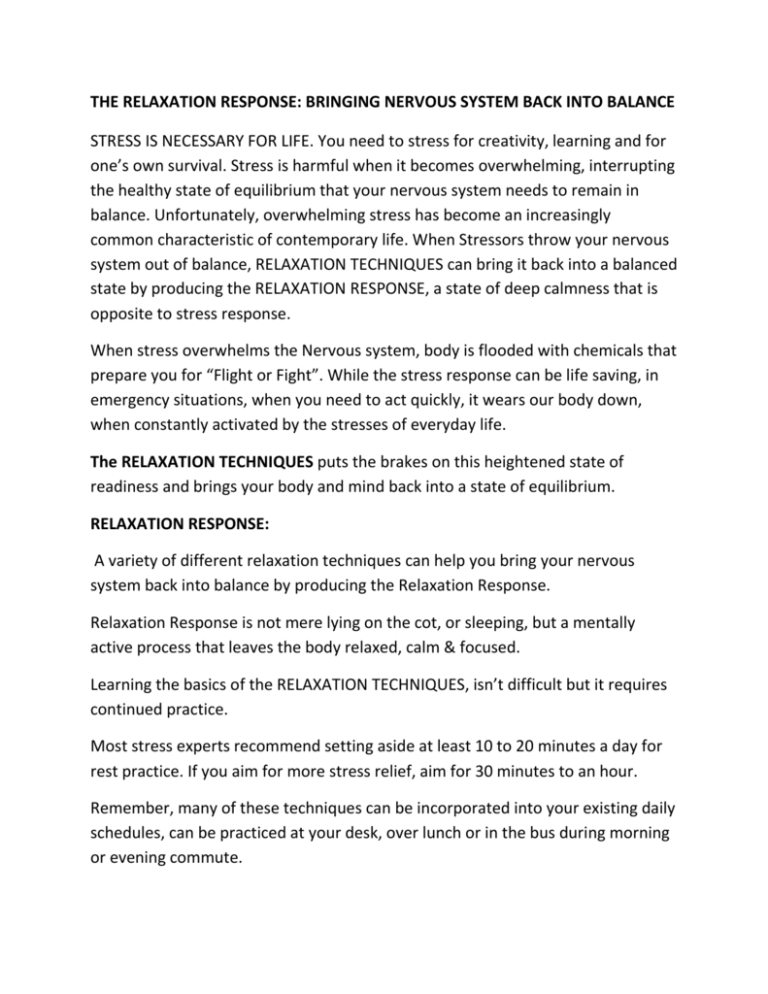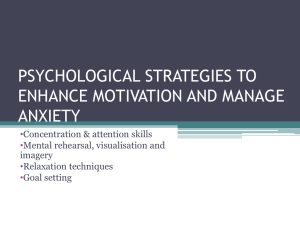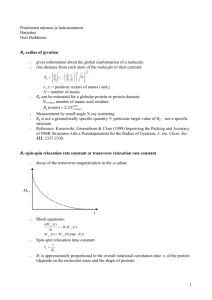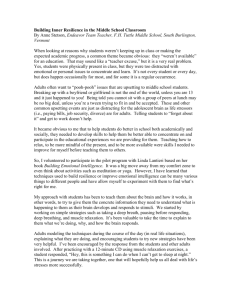Relaxation Techniques
advertisement

THE RELAXATION RESPONSE: BRINGING NERVOUS SYSTEM BACK INTO BALANCE STRESS IS NECESSARY FOR LIFE. You need to stress for creativity, learning and for one’s own survival. Stress is harmful when it becomes overwhelming, interrupting the healthy state of equilibrium that your nervous system needs to remain in balance. Unfortunately, overwhelming stress has become an increasingly common characteristic of contemporary life. When Stressors throw your nervous system out of balance, RELAXATION TECHNIQUES can bring it back into a balanced state by producing the RELAXATION RESPONSE, a state of deep calmness that is opposite to stress response. When stress overwhelms the Nervous system, body is flooded with chemicals that prepare you for “Flight or Fight”. While the stress response can be life saving, in emergency situations, when you need to act quickly, it wears our body down, when constantly activated by the stresses of everyday life. The RELAXATION TECHNIQUES puts the brakes on this heightened state of readiness and brings your body and mind back into a state of equilibrium. RELAXATION RESPONSE: A variety of different relaxation techniques can help you bring your nervous system back into balance by producing the Relaxation Response. Relaxation Response is not mere lying on the cot, or sleeping, but a mentally active process that leaves the body relaxed, calm & focused. Learning the basics of the RELAXATION TECHNIQUES, isn’t difficult but it requires continued practice. Most stress experts recommend setting aside at least 10 to 20 minutes a day for rest practice. If you aim for more stress relief, aim for 30 minutes to an hour. Remember, many of these techniques can be incorporated into your existing daily schedules, can be practiced at your desk, over lunch or in the bus during morning or evening commute. RELAXATION TECHNIQUES FOR STRESS RELIEF: For most of us, relaxation means to sit in front of the TV or use some other technological device at the end of a stressful day. But that in no way helps to reduce the damaging effects of stress. To effectively combat stress, we need to activate the body’s natural relaxation response. This can be done by practicing Relaxation Techniques such as Deep Breathing; Progressive Relaxation Techniques; Mindful Meditation; Rhythmic Exercise (Aerobics) and Yoga Taking time out for a regular fixed time schedule to fit these activities into day to day life can help reduce day to day stress and boost your energy and mood. RELAXATION TECHNIQUE -1: Breathing Meditation for Stress Relief: With its focus on full, cleansing breaths, deep breathing is simple, yet powerful relaxation technique. It is easy to learn, can be practiced almost anywhere and provides a quick way to get your stress levels in check. All that is needed is a few minutes and a place to stretch out. Practicing Deep Breathing Meditation: The key to deep breathing is to breathe deeply from abdomen, getting as much fresh air as possible in your lungs. When you take deep breaths from the abdomen, rather than shallow breaths from your Upper Chest, you inhale more oxygen. The more Oxygen you get, the less tense, less short of breath and less anxiety you feel. STEPS: Sit comfortably with your back straight. Put one hand on your chest and the other on your stomach. Breathe in through your NOSE. The hand on your stomach should rise. The hand on your chest should move very little. Exhale through your mouth, pushing out as much air as you can while contracting your abdominal muscles. The hand on your stomach should move in as you exhale, but your other hand should move very little. Continue to breathe in through your NOSE & out through your MOUTH Try to inhale enough so that your lower abdomen rises & falls. Count slowly as you exhale RELAXATION TECHNIQUE -2: Progressive Muscle Relaxation for Stress relief—PMR PMR involves two step process in which you systematically “tense &relax” different muscle groups in the body. PMR gives intimate familiarity with what tension as well as complete relaxation feels like in different parts of the body.s This awareness helps to spot and counteract the first signs of the muscular tension that accompanies stress. And as your body relaxes, so will your mind. You can combine deep breathing with progressive Muscle Relaxation for additional level of Stress Relief. PRACTICING PMR: Loosen clothing, take off shoes, and get comfortable. Take few minutes to relax, breathe in & out in slow deep breaths. Pay attention on to your RIGHT FOOT. Focus on the way it feels. Slowly TENSE the muscles in your right foot, squeezing as tightly as you can. HOLD FOR A COUNT OF 10. Slowly RELAX the tension on RF. Stay for a moment. Take deep Breaths. Shift your attention to your LEFT FOOT. Follow the same sequence of muscle tension & Relaxation. Move slowly up through your body, contracting & relaxing the muscle groups as you go. SEQUENCE OF TENSION & RELAXATION: 1. Right Foot 2. Left Foot 3. Right Calf 4. Left Calf 5. Right Thigh 6. Left thigh 7. Hips & Buttocks 8. Stomach 9. Chest 10. Back 11. Right arm & Hand 12. Left arm & Hand 13. Neck & Shoulders 14. Face. RELAXATION TECHNIQUE—3: Mindful Meditation for Stress Relief: Mindfulness focuses on staying calm and living in the present moment. It is the ability to remain aware of how you are feeling at the moment, the experience of both INTERNAL & EXTERNAL. Thinking about the past-Blaming and judging yourself or worrying about the FUTURE can often lead to a degree of stress that is overwhelming. But by staying calm & Focused in the present moment, you can bring your Nervous System back into balance. This can be applied to activities as WALKING, CYCLING, EXERCISING, EATING, or anything that you at that point in time. Mindful meditations have long been used to reduce overwhelming stress by focusing attention on a single repetitive action. You can focus on your own Breathing at the moment, on a flower in the garden, or on anything that will bring a smile onto your lips and brighten your face up. You can light a candle & focus on the tip of the flame, gently close your eyes and see the imagery within. When this is done, external thoughts may interrupt, but you should gently bring back your attention to the focus of your thought. Practicing Mind full Meditation: Key Points : Quiet Environment; Comfortable Position; Point of Focus; Observant NON-Critical Attitude, Not worrying about intruding thoughts or on how well you are practicing. It is suggested not to fight against the intruding thoughts during the session. Instead, gently turn your attention back to your point of focus. LIVE IN THE PRESENT MOMENT, ENJOY THAT MOMENT, AVOID THINKING OF PAST CONSCIOUSLY RELAXATION TECHNIQUE—5: VISUALIZATION OR GUIDED IMAGERY Visualization or guided imagery is a variation on traditional meditation that requires to use all the sensory organs. When used as a Relaxation Technique, Visualization involves imagining a scene in which you feel at peace, free to let go off all tension & anxiety. Belief in SELF should be optimum. Choose whatever setting is most calming to your. This visualization exercise can be done on your own in silence, while listening to soothing music. PRACTISING VISUAL RELAXATION: Find a quiet relaxed place. Close your eyes and let your worries drift away. Imagine a place of your choice that would give you a soothing feeling, help you to feel rested. Picturise it as vividly as you can using all your senses. Visualization works best if you incorporate as many sensory details as possible, using a minimum of 3 of your senses. When visualizing, choose imagery that appeals to you in your daily life. If your imagination is on a quiet lake as SANKEY TANK, nearby, or DEER PARK within the campus, visualize as if you are walking around the lake, seeing all the places around. Spend some time exploring each of your senses. See the sun rising/setting over the water. Hear the Birds singing, Smell the fragrance from trees, Feel the cool breeze, feel the cold water on your bare feet. Taste the fresh & clean air. Enjoy the feeling of deep relaxation that envelopes you as you lowly explore your restful place. When you are ready gently open your eyes and come back to the present. RELAXATION TECHNIQUE-5: YOGA Yoga involves a series of both moving & stationery poses, combined with Deep Breathing. In addition to reducing anxiety & Stress, Yoga can also improve Flexibility, Strength, and Balance & Stamina. If Yoga is practiced regularly, it can also strengthen the relaxation response in daily life. It is best to learn by attending in Group, under a trained Yoga Expert. Pathanjali yoga is suggested. Although almost all yoga classes end in Relaxation, classes that emphasize low, steady movement, deep Breathing and gentle stretching are best for stress relief. TAI CHI: It is a self- paced, non-competitive series of slow flowing body movements. These movements emphasize concentration, relaxation & the conscious circulation of vital energy throughout the body. Though TAI_CHI has its roots in Martial Arts, today it is primarily practiced as a way of calming the mind, conditioning the body and reducing the stress. As in meditation, Taichi practioners focus on their breathing & keeping their attention onto the present moment. Aerobic exercise is also a very useful stress buster.







